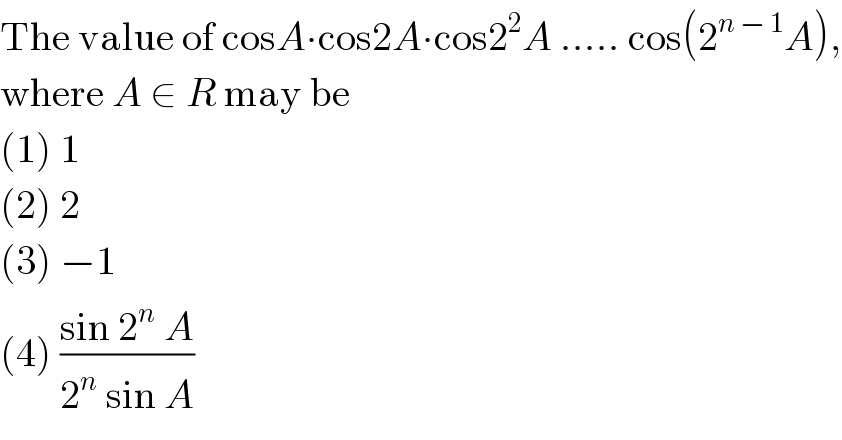Question Number 18003 by Tinkutara last updated on 13/Jul/17

$$\mathrm{The}\:\mathrm{value}\:\mathrm{of}\:\mathrm{cos}{A}\centerdot\mathrm{cos2}{A}\centerdot\mathrm{cos2}^{\mathrm{2}} {A}\:…..\:\mathrm{cos}\left(\mathrm{2}^{{n}\:−\:\mathrm{1}} {A}\right), \\ $$$$\mathrm{where}\:{A}\:\in\:{R}\:\mathrm{may}\:\mathrm{be} \\ $$$$\left(\mathrm{1}\right)\:\mathrm{1} \\ $$$$\left(\mathrm{2}\right)\:\mathrm{2} \\ $$$$\left(\mathrm{3}\right)\:−\mathrm{1} \\ $$$$\left(\mathrm{4}\right)\:\frac{\mathrm{sin}\:\mathrm{2}^{{n}} \:{A}}{\mathrm{2}^{{n}} \:\mathrm{sin}\:{A}} \\ $$
Answered by alex041103 last updated on 13/Jul/17
![Let E=cos(A)cos(2A)...=Π_(k=0) ^(n−1) cos(2^k A) Because sin(2^(k+1) A)=2sin(2^k A)cos(2^k A) ⇒cos(2^k A)=((sin(2^(k+1) A))/(2sin(2^k A))) ⇒E=Π_(k=0) ^(n−1) ((sin(2^(k+1) A))/(2sin(2^k A)))= =[Π_(k=0) ^(n−1) sin(2^(k+1) A)]×[Π_(k=0) ^(n−1) (1/(2sin(2^k A)))] =((sin(2^n A))/(2sin(A)))[Π_(k=0) ^(n−2) sin(2^(k+1) A)][Π_(k=1) ^(n−1) (1/(2sin(2^k A)))] =((sin(2^n A))/(2sin(A)))[Π_(k=1) ^(n−1) sin(2^k A)][Π_(k=1) ^(n−1) (1/(2sin(2^k A)))] =((sin(2^n A))/(2sin(A)))[Π_(k=1) ^(n−1) ((sin(2^k A))/(2sin(2^k A)))] =((sin(2^n A))/(2sin(A)))[Π_(k=1) ^(n−1) (1/2)] =((sin(2^n A))/(2sin(A)))×(1/2^(n−1) ) =((sun(2^n A))/(2^n sin(A))) = cos(A)cos(2A)...](https://www.tinkutara.com/question/Q18010.png)
$${Let}\:{E}={cos}\left({A}\right){cos}\left(\mathrm{2}{A}\right)…=\underset{{k}=\mathrm{0}} {\overset{{n}−\mathrm{1}} {\prod}}{cos}\left(\mathrm{2}^{{k}} {A}\right) \\ $$$${Because}\:{sin}\left(\mathrm{2}^{{k}+\mathrm{1}} {A}\right)=\mathrm{2}{sin}\left(\mathrm{2}^{{k}} {A}\right){cos}\left(\mathrm{2}^{{k}} {A}\right) \\ $$$$\Rightarrow{cos}\left(\mathrm{2}^{{k}} {A}\right)=\frac{{sin}\left(\mathrm{2}^{{k}+\mathrm{1}} {A}\right)}{\mathrm{2}{sin}\left(\mathrm{2}^{{k}} {A}\right)} \\ $$$$\Rightarrow{E}=\underset{{k}=\mathrm{0}} {\overset{{n}−\mathrm{1}} {\prod}}\frac{{sin}\left(\mathrm{2}^{{k}+\mathrm{1}} {A}\right)}{\mathrm{2}{sin}\left(\mathrm{2}^{{k}} {A}\right)}= \\ $$$$=\left[\underset{{k}=\mathrm{0}} {\overset{{n}−\mathrm{1}} {\prod}}{sin}\left(\mathrm{2}^{{k}+\mathrm{1}} {A}\right)\right]×\left[\underset{{k}=\mathrm{0}} {\overset{{n}−\mathrm{1}} {\prod}}\frac{\mathrm{1}}{\mathrm{2}{sin}\left(\mathrm{2}^{{k}} {A}\right)}\right] \\ $$$$=\frac{{sin}\left(\mathrm{2}^{{n}} {A}\right)}{\mathrm{2}{sin}\left({A}\right)}\left[\underset{{k}=\mathrm{0}} {\overset{{n}−\mathrm{2}} {\prod}}{sin}\left(\mathrm{2}^{{k}+\mathrm{1}} {A}\right)\right]\left[\underset{{k}=\mathrm{1}} {\overset{{n}−\mathrm{1}} {\prod}}\frac{\mathrm{1}}{\mathrm{2}{sin}\left(\mathrm{2}^{{k}} {A}\right)}\right] \\ $$$$=\frac{{sin}\left(\mathrm{2}^{{n}} {A}\right)}{\mathrm{2}{sin}\left({A}\right)}\left[\underset{{k}=\mathrm{1}} {\overset{{n}−\mathrm{1}} {\prod}}{sin}\left(\mathrm{2}^{{k}} {A}\right)\right]\left[\underset{{k}=\mathrm{1}} {\overset{{n}−\mathrm{1}} {\prod}}\frac{\mathrm{1}}{\mathrm{2}{sin}\left(\mathrm{2}^{{k}} {A}\right)}\right] \\ $$$$=\frac{{sin}\left(\mathrm{2}^{{n}} {A}\right)}{\mathrm{2}{sin}\left({A}\right)}\left[\underset{{k}=\mathrm{1}} {\overset{{n}−\mathrm{1}} {\prod}}\frac{{sin}\left(\mathrm{2}^{{k}} {A}\right)}{\mathrm{2}{sin}\left(\mathrm{2}^{{k}} {A}\right)}\right] \\ $$$$=\frac{{sin}\left(\mathrm{2}^{{n}} {A}\right)}{\mathrm{2}{sin}\left({A}\right)}\left[\underset{{k}=\mathrm{1}} {\overset{{n}−\mathrm{1}} {\prod}}\frac{\mathrm{1}}{\mathrm{2}}\right] \\ $$$$=\frac{{sin}\left(\mathrm{2}^{{n}} {A}\right)}{\mathrm{2}{sin}\left({A}\right)}×\frac{\mathrm{1}}{\mathrm{2}^{{n}−\mathrm{1}} } \\ $$$$=\frac{{sun}\left(\mathrm{2}^{{n}} {A}\right)}{\mathrm{2}^{{n}} {sin}\left({A}\right)}\:=\:{cos}\left({A}\right){cos}\left(\mathrm{2}{A}\right)… \\ $$
Commented by Tinkutara last updated on 13/Jul/17

$$\mathrm{But}\:\mathrm{which}\:\mathrm{options}\:\mathrm{are}\:\mathrm{correct}?\:\mathrm{It}\:\mathrm{can} \\ $$$$\mathrm{have}\:\mathrm{more}\:\mathrm{than}\:\mathrm{one}\:\mathrm{option}\left(\mathrm{s}\right). \\ $$
Commented by alex041103 last updated on 13/Jul/17

$${you}'{re}\:{right} \\ $$$${it}\:{can}\:{be}\:\mathrm{1}\:{when}\:{A}=\mathrm{2}\pi \\ $$$${and}\:\:−\mathrm{1}\:{for}\:{A}=\pi\:{and}\:{n}=\mathrm{1} \\ $$$${but}\:{i}'{m}\:{still}\:{thinking}\:{about}\:{the}\:\mathrm{2} \\ $$
Commented by Tinkutara last updated on 13/Jul/17

$$\mathrm{Thanks}\:\mathrm{Sir}! \\ $$
